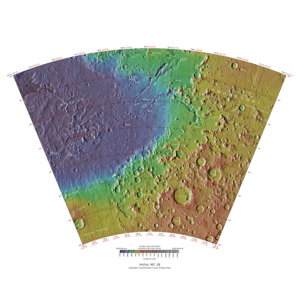Hellas quadrangle
|
Map of Hellas quadrangle from Mars Orbiter Laser Altimeter (MOLA) data. The highest elevations are red and the lowest are blue. | |
| Coordinates | 47°30′S 270°00′W / 47.5°S 270°WCoordinates: 47°30′S 270°00′W / 47.5°S 270°W |
|---|---|
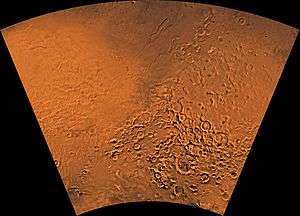
The Hellas quadrangle is one of a series of 30 quadrangle maps of Mars used by the United States Geological Survey (USGS) Astrogeology Research Program. The Hellas quadrangle is also referred to as MC-28 (Mars Chart-28).[1] The Hellas quadrangle covers the area from 240° to 300° west longitude and 30° to 65° south latitude on the planet Mars. Within the Hellas quadrangle lies the classic features Hellas Planitia and Promethei Terra. Many interesting and mysterious features have been discovered in the Hellas quadrangle, including the giant river valleys Dao Vallis, Niger Vallis, Harmakhis, and Reull Vallis—all of which may have contributed water to a lake in the Hellas basin in the distant past.[2][3][4] Many places in the Hellas quadrangle show signs of ice in the ground, especially places with glacier-like flow features.
Hellas Basin
The Hellas quadrangle contains part of the Hellas Basin, the largest known impact crater on the surface of Mars and the second largest in the solar system. The depth of the crater is 7152 m[5] (23,000 ft) below the standard topographic datum of Mars. The basin is located in the southern highlands of Mars and is thought to have been formed about 3.9 billion years ago, during the Late Heavy Bombardment. Studies suggest that when an impact created the Hellas Basin, the entire surface of Mars was heated hundreds of degrees, 70 meters of molted rock fell on the planet, and an atmosphere of gaseous rock was formed. This rock atmosphere was 10 times as thick as the Earth's atmosphere. In a few days, the rock would have condensed out and covered the whole planet with an additional 10 m of molten rock.[2] In the Northwest portion of Hellas Planitia is a strange type of surface called complex banded terrain or taffy-pull terrain. Its process of formation is still largely unknown, although it appears to be due to erosion of hard and soft sediment along with ductile deformation. Ductile deformation results from layers undergoing strain.[6]
Early in the planet's history, it is believed that a giant lake existed in the Hellas Basin.[7] Possible shorelines have been discovered. These are evident in alternating benches and scarps visible in Mars orbiting camera narrow-angle images. In addition, Mars orbiting laser altimeter (MOLA) data show that the contacts of these sedimentary units mark contours of constant elevation for thousands of km, and in one case all around the basin. Channels, believed to be formed by water, enter into the basin. The Hellas drainage basin may be almost one-fifth that of the entire northern plains. A lake in Hellas in today's Martian climate would form a thick ice at the top that would eventually sublimate away. That is the ice would turn directly from a solid to a gas. This is similar to how dry ice (solid carbon dioxide) behaves on Earth.[3] Glacial features (terminal moraines, drumlins, and eskers) have been found that may have been formed when the water froze.[2][8]
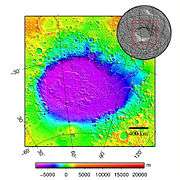
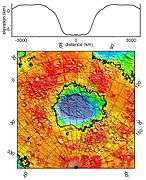
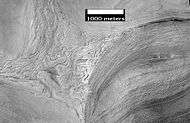 Twisted Ground in Hellas, as seen by HiRISE. This is one more example of how difficult it would be to walk on Mars.
Twisted Ground in Hellas, as seen by HiRISE. This is one more example of how difficult it would be to walk on Mars.
Lobate debris aprons
One very important feature common in east Hellas are piles of material surrounding cliffs. The formation is called a lobate debris apron (LDA). Recently, research with the Shallow Radar on the Mars Reconnaissance Orbiter has provided strong evidence that the LDAs are glaciers that are covered with a thin layer of rocks.[9][10][11][12][13] Large amounts of water ice are believed to be in the LDAs. Available evidence strongly suggests that the eastern part of Hellas accumulated snow in the past. When the tilt (obliquity) of Mars increases the southern ice cap releases large amounts of water vapor. Climate models predict that when this occurs, water vapor condenses and falls where LDAs are located. The tilt of the earth changes little because our relatively large moon keeps it stable. The two tiny Martian moons do not stabilize their planet, so the rotational axis of Mars undergoes large variations.[14] Lobate debris aprons may be a major source of water for future Mars colonists. Their major advantage over other sources of Martian water are that they can easily mapped from orbit and they are closer to the equator, where manned missions are more likely to land.
 Close-up of surface of a lobate debris apron. Note the lines that are common in rock glaciers on the Earth. Image located in Hellas quadrangle.
Close-up of surface of a lobate debris apron. Note the lines that are common in rock glaciers on the Earth. Image located in Hellas quadrangle.- CTX Context image for next two images of debris apron around mound.
- Surface of Debris Apron. There is also a feature similar to features in Red Rocks Park Colorado. Feature seems to be composed of slanted rock layers. Image taken with HiRISE, under the HiWish program.
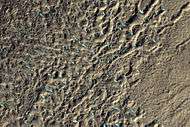 Surface of debris apron in Terra Cimmeria, as seen by HiRISE, under the HiWish program. Colored parts may be frost deposits.
Surface of debris apron in Terra Cimmeria, as seen by HiRISE, under the HiWish program. Colored parts may be frost deposits.
Lineated Floor Deposits
On the floors of some channels are features called lineated floor deposits. They are ridged and grooved materials that seem to deflect around obstacles. They are believed to be ice-rich. Some glaciers on the Earth show such features. Lineated floor deposits may be related to lobate debris aprons, which have been proven to contain large amounts of ice. Reull Vallis, as pictured below, displays these deposits.[15]
- Drainage features in Reull Vallis, as seen by THEMIS. Click on image to see relationship of Reull Vallis to other features.
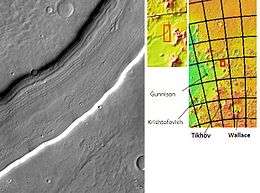 Reull Vallis with lineated floor deposits, as seen by THEMIS. Click on image to see relationship to other features.
Reull Vallis with lineated floor deposits, as seen by THEMIS. Click on image to see relationship to other features.- Layers in Reull Vallis, as seen by THEMIS.
 Fretted terrain near Reull Vallis, as seen by HiRISE.
Fretted terrain near Reull Vallis, as seen by HiRISE.- Close-up of Fretted Terrain near Reull Vallis, as seen by HiRISE. This area would be a challenge to walk across.
 Layers in Monument Valley. These are accepted as being formed, at least in part, by water deposition. Since Mars contains similar layers, water remains as a major cause of layering on Mars.
Layers in Monument Valley. These are accepted as being formed, at least in part, by water deposition. Since Mars contains similar layers, water remains as a major cause of layering on Mars.
Ice-rich mantle
Much of the surface of Mars is covered by a thick smooth mantle that is thought to be a mixture of ice and dust. This ice-rich mantle, a few yards thick, smoothes the land, but in places it displays a bumpy texture, resembling the surface of a basketball. Because there are few craters on this mantle, the mantle is relatively young. The image at the right shows a good view of this smooth mantle around Niger Vallis, as observed with HiRISE. Changes in Mars's orbit and tilt cause significant changes in the distribution of water ice from polar regions down to latitudes equivalent to Texas. During certain climate periods water vapor leaves polar ice and enters the atmosphere. The water returns to the ground at lower latitudes as deposits of frost or snow mixed generously with dust. The atmosphere of Mars contains a great deal of fine dust particles. Water vapor condenses on the particles, then they fall down to the ground due to the additional weight of the water coating. When ice at the top of the mantling layer goes back into the atmosphere, it leaves behind dust, which insulates the remaining ice.[16]
 Smooth mantle with layers, as seen by HiRISE under HiWish program
Smooth mantle with layers, as seen by HiRISE under HiWish program Close view of mantle, as seen by HiRISE under HiWish program
Close view of mantle, as seen by HiRISE under HiWish program
Upper Plains Unit
\
 Layered feature probably formed by the erosion of the upper plains unit, as seen by HiRISE under HiWish program.
Layered feature probably formed by the erosion of the upper plains unit, as seen by HiRISE under HiWish program.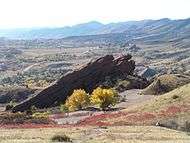 Layered feature in Red Rocks Park, Colorado. This has a different origin than ones on Mars, but it has a similar shape. Features in Red Rocks region were caused by uplift of mountains.
Layered feature in Red Rocks Park, Colorado. This has a different origin than ones on Mars, but it has a similar shape. Features in Red Rocks region were caused by uplift of mountains. Layered feature that is probably the remains of a once widespread unit that fell from the sky, as seen by HiRISE under the HiWish program
Layered feature that is probably the remains of a once widespread unit that fell from the sky, as seen by HiRISE under the HiWish program Layered feature, as seen by HiRISE under the HiWish program
Layered feature, as seen by HiRISE under the HiWish program Layered feature in crater, as seen by HiRISE under the HiWish program
Layered feature in crater, as seen by HiRISE under the HiWish program Layered feature in crater, as seen by HiRISE under the HiWish program
Layered feature in crater, as seen by HiRISE under the HiWish program Layers in crater, as seen by HiRISE under HiWish program
Layers in crater, as seen by HiRISE under HiWish program
Remnants of a 50-100 meter thick mantling, called the upper plains unit, has been discovered in the mid-latitudes of Mars. First investigated in the Deuteronilus Mensae region, but it occurs in other places as well. The remnants consist of sets of dipping layers in craters and along mesas.[17] Sets of dipping layers may be of various sizes and shapes—some look like Aztec pyramids from Central America.
 Layered structure in crater that is probably what is left of a layered unit that once covered a much larger area. Material for this unit fell from the sky as ice-coated dust. The picture was taken by HiRISE, under the HiWish program.
Layered structure in crater that is probably what is left of a layered unit that once covered a much larger area. Material for this unit fell from the sky as ice-coated dust. The picture was taken by HiRISE, under the HiWish program.
This unit also degrades into brain terrain. Brain terrain is a region of maze-like ridges 3–5 meters high. Some ridges may consist of an ice core, so they may be sources of water for future colonists.
 Small, layered structure, as seen by HiRISE under the HiWish program Picture also shows brain terrain forming.
Small, layered structure, as seen by HiRISE under the HiWish program Picture also shows brain terrain forming.
Some regions of the upper plains unit display large fractures and troughs with raised rims; such regions are called ribbed upper plains. Fractures are believed to have started with small cracks from stresses. Stress is suggested to initiate the fracture process since ribbed upper plains are common when debris aprons come together or near the edge of debris aprons—such sites would generate compressional stresses. Cracks exposed more surfaces, and consequently more ice in the material sublimates into the planet's thin atmosphere. Eventually, small cracks become large canyons or troughs. Small cracks often contain small pits and chains of pits; these are thought to be from sublimation of ice in the ground.[18][19] Large areas of the Martian surface are loaded with ice that is protected by a meters thick layer of dust and other material. However, if cracks appear, a fresh surface will expose ice to the thin atmosphere.[20][21] In a short time, the ice will disappear into the cold, thin atmosphere in a process called sublimation. Dry ice behaves in a similar fashion on the Earth. On Mars sublimation has been observed when the Phoenix lander uncovered chunks of ice that disappeared in a few days.[22][23] In addition, HiRISE has seen fresh craters with ice at the bottom. After a time, HiRISE saw the ice deposit disappear.[24]
 Die-sized clumps of bright material in the enlarged "Dodo-Goldilocks" trench vanished over the course of four days, implying that they were composed of ice which sublimated following exposure.[23][25]
Die-sized clumps of bright material in the enlarged "Dodo-Goldilocks" trench vanished over the course of four days, implying that they were composed of ice which sublimated following exposure.[23][25]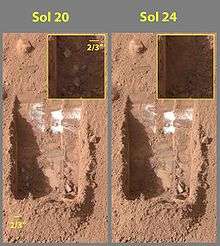 Color versions of the photos showing ice sublimation, with the lower left corner of the trench enlarged in the insets in the upper right of the images.
Color versions of the photos showing ice sublimation, with the lower left corner of the trench enlarged in the insets in the upper right of the images.
The upper plains unit is thought to have fallen from the sky. It drapes various surfaces, as if it fell evenly. As is the case for other mantle deposits, the upper plains unit has layers, is fine-grained, and is ice-rich. It is widespread; it does not seem to have a point source. The surface appearance of some regions of Mars is due to how this unit has degraded. It is a major cause of the surface appearance of lobate debris aprons.[19] The layering of the upper plains mantling unit and other mantling units are believed to be caused by major changes in the planet's climate. Models predict that the obliquity or tilt of the rotational axis has varied from its present 25 degrees to maybe over 80 degrees over geological time. Periods of high tilt will cause the ice in the polar caps to be redistributed and change the amount of dust in the atmosphere.[26][27][28]
Climate change caused ice-rich features
Many features on Mars, including ones in Hellas quadrangle, are believed to contain large amounts of ice. The most popular model for the origin of the ice is climate change from large changes in the tilt of the planet's rotational axis. At times the tilt has even been greater than 80 degrees[29][30] Large changes in the tilt explains many ice-rich features on Mars.
Studies have shown that when the tilt of Mars reaches 45 degrees from its current 25 degrees, ice is no longer stable at the poles.[31] Furthermore, at this high tilt, stores of solid carbon dioxide (dry ice) sublimate, thereby increasing the atmospheric pressure. This increased pressure allows more dust to be held in the atmosphere. Moisture in the atmosphere will fall as snow or as ice frozen onto dust grains. Calculations suggest this material will concentrate in the mid-latitudes.[32][33] General circulation models of the Martian atmosphere predict accumulations of ice-rich dust in the same areas where ice-rich features are found.[34] When the tilt begins to return to lower values, the ice sublimates (turns directly to a gas) and leaves behind a lag of dust.[35][35][36] The lag deposit caps the underlying material so with each cycle of high tilt levels, some ice-rich mantle remains behind.[37] Note, that the smooth surface mantle layer probably represents only relative recent material.
Origin of Dao Vallis
Dao Vallis begins near a large volcano, called Hadriaca Patera, so it is thought to have received water when hot magma melted huge amounts of ice in the frozen ground.[2] The partially circular depressions on the left side of the channel in the adjacent image suggests that groundwater sapping also contributed water.[38]
Dust devil tracks
Many areas on Mars, including the Hellas quadrangle, experience the passage of giant dust devils. A thin coating of fine bright dust covers most of the martian surface. When a dust devil goes by it blows away the coating and exposes the underlying dark surface. Dust devils have been seen from the ground and from orbiting spacecraft. They have even blown the dust off of the solar panels of the two Rovers on Mars, thereby greatly extending their lives.[39] The twin Rovers were designed to last for 3 months, instead they have lasted more than five years and are still going. The pattern of the tracks have been shown to change every few months.[40] A study that combined data from the High Resolution Stereo Camera (HRSC) and the Mars Orbiter Camera (MOC) found that some large dust devils on Mars have a diameter of 700 meters and last at least 26 minutes.[41]
Evidence for possible recent liquid water
The Mars Reconnaissance Orbiter discovered changes on the wall of Penticton Crater between 1999 and 2004. One interpretation of the changes was that they were caused by water flowing on the surface.[42] A further analysis, published about a year later, revealed that the deposit could have been caused by gravity moving material down slope (a landslide). The slope where the deposit was sighted was close to the stability limits of dry, unconsolidated materials.[43]
Other Craters
Impact craters generally have a rim with ejecta around them, in contrast volcanic craters usually do not have a rim or ejecta deposits. As craters get larger (greater than 10 km in diameter) they usually have a central peak.[44] The peak is caused by a rebound of the crater floor following the impact.[45] Sometimes craters will display layers. Craters can show us what lies deep under the surface.
 Pedestal craters form when the ejecta from impacts protect the underlying material from erosion. As a result of this process, craters appear perched above their surroundings.
Pedestal craters form when the ejecta from impacts protect the underlying material from erosion. As a result of this process, craters appear perched above their surroundings. Drawing shows a later idea of how some pedestal craters form. In this way of thinking, an impacting projectile goes into an ice-rich layer—but no further. Heat and wind from the impact hardens the surface against erosion. This hardening can be accomplished by the melting of ice which produces a salt/mineral solution thereby cementing the surface.
Drawing shows a later idea of how some pedestal craters form. In this way of thinking, an impacting projectile goes into an ice-rich layer—but no further. Heat and wind from the impact hardens the surface against erosion. This hardening can be accomplished by the melting of ice which produces a salt/mineral solution thereby cementing the surface.- Stair-stepping mesas in interior deposit of Spallanzani Crater, as seen by THEMIS
- Penticton Crater gullies, as seen by HiRISE
 Lipik Crater Channels, as seen by THEMIS.
Lipik Crater Channels, as seen by THEMIS. Tikhov Crater, as seen by CTX camera (on Mars Reconnaissance Orbiter).
Tikhov Crater, as seen by CTX camera (on Mars Reconnaissance Orbiter).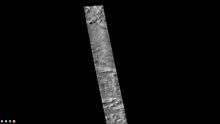 Floor of Wallace Crater, as seen by CTX camera (on Mars Reconnaissance Orbiter).
Floor of Wallace Crater, as seen by CTX camera (on Mars Reconnaissance Orbiter).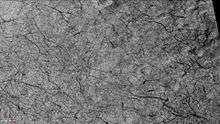 Dust devil tracks on floor of Wallace Crater, as seen by CTX camera (on Mars Reconnaissance Orbiter). Note this is an enlargement of the previous image of the floor of Wallace Crater.
Dust devil tracks on floor of Wallace Crater, as seen by CTX camera (on Mars Reconnaissance Orbiter). Note this is an enlargement of the previous image of the floor of Wallace Crater. Huxley Crater, as seen by CTX camera (on Mars Reconnaissance Orbiter).
Huxley Crater, as seen by CTX camera (on Mars Reconnaissance Orbiter). Gledhill Crater, as seen by CTX camera (on Mars Reconnaissance Orbiter).
Gledhill Crater, as seen by CTX camera (on Mars Reconnaissance Orbiter). Le Verrier (Martian Crater), as seen by CTX camera (on Mars Reconnaissance Orbiter).
Le Verrier (Martian Crater), as seen by CTX camera (on Mars Reconnaissance Orbiter).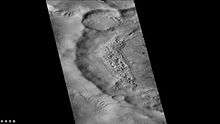 Redi Crater, as seen by CTX camera (on Mars Reconnaissance Orbiter).
Redi Crater, as seen by CTX camera (on Mars Reconnaissance Orbiter). Redi Crater, showing dust devil tracks and mantle, as seen by CTX camera (on Mars Reconnaissance Orbiter). Note: this is an enlargement of the previous image of Redi Crater.
Redi Crater, showing dust devil tracks and mantle, as seen by CTX camera (on Mars Reconnaissance Orbiter). Note: this is an enlargement of the previous image of Redi Crater.
Glacial Features
- Surface features that show down hill movement, as seen by HiRISE.
- CTX context image of Hellas Planitia showing location of next two images.
- Surface in Hellas quadrangle, as seen by HiRISE, under the HiWish program.
- Possible Glacial Cirque in Hellas Planitia, as seen by HiRISE, under the HiWish program. Lines are probably due to downhill movement.
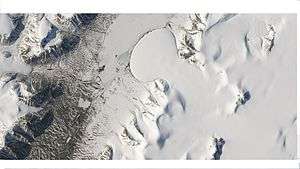 Romer Lake's Elephant Foot Glacier in the Earth's Arctic, as seen by Landsat 8. This picture shows several glaciers that have the same shape as many features on Mars that are believed to also be glaciers.
Romer Lake's Elephant Foot Glacier in the Earth's Arctic, as seen by Landsat 8. This picture shows several glaciers that have the same shape as many features on Mars that are believed to also be glaciers. Flow feature that was probably a glacier, as seen by HiRISE under HiWish program
Flow feature that was probably a glacier, as seen by HiRISE under HiWish program Flow ridges, as seen by HiRISE under the HiWish program Ridges probably formed at the end of old glacier.
Flow ridges, as seen by HiRISE under the HiWish program Ridges probably formed at the end of old glacier. Context for the next image of the end of a flow feature or glacier. Location is Hellas quadrangle.
Context for the next image of the end of a flow feature or glacier. Location is Hellas quadrangle.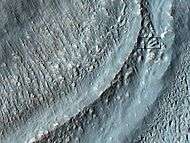 Close-up of the area in the box in the previous image. This may be called by some the terminal moraine of a glacier. For scale, the box shows the approximate size of a football field. Image taken with HiRISE under the HiWish program. Location is Hellas quadrangle.
Close-up of the area in the box in the previous image. This may be called by some the terminal moraine of a glacier. For scale, the box shows the approximate size of a football field. Image taken with HiRISE under the HiWish program. Location is Hellas quadrangle.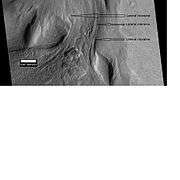 Material Flowing through a crater rim, as seen by HiRISE, under the HiWish program. Lateral moraines are labeled.
Material Flowing through a crater rim, as seen by HiRISE, under the HiWish program. Lateral moraines are labeled. Glaciers, as seen by HiRISE, under HiWish program. Glacier on left is thin because it has lost much of its ice. Glacier on the right, on the other hand, is thick; it still contains a lot of ice that is under a thin layer of dirt and rock.
Glaciers, as seen by HiRISE, under HiWish program. Glacier on left is thin because it has lost much of its ice. Glacier on the right, on the other hand, is thick; it still contains a lot of ice that is under a thin layer of dirt and rock.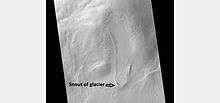 Tongue-shaped glacier, as seen by HiRISE under the HiWish program. Ice may exist in the glacier, even today, beneath an insulating layer of dirt.
Tongue-shaped glacier, as seen by HiRISE under the HiWish program. Ice may exist in the glacier, even today, beneath an insulating layer of dirt. Close-up of tongue-shaped glacier, as seen by HiRISE under the HiWish program Resolution is about 1 meter, so one can see objects a few meters across in this image. Ice may exist in the glacier, even today, beneath an insulating layer of dirt.
Close-up of tongue-shaped glacier, as seen by HiRISE under the HiWish program Resolution is about 1 meter, so one can see objects a few meters across in this image. Ice may exist in the glacier, even today, beneath an insulating layer of dirt. Tongue-shaped glaciers indicated with arrows, as seen by HiRISE under the HiWish program
Tongue-shaped glaciers indicated with arrows, as seen by HiRISE under the HiWish program Close view of snout of glacier, as seen by HiRISE under the HiWish program High center polygons are visible. Box shows size of football field.
Close view of snout of glacier, as seen by HiRISE under the HiWish program High center polygons are visible. Box shows size of football field. Close view of high center ploygons near glacier, as seen by HiRISE under the HiWish program
Close view of high center ploygons near glacier, as seen by HiRISE under the HiWish program Close view of high center ploygons near glacier, as seen by HiRISE under the HiWish program
Close view of high center ploygons near glacier, as seen by HiRISE under the HiWish program Close view of high center ploygons near glacier, as seen by HiRISE under the HiWish program Box shows size of football field.
Close view of high center ploygons near glacier, as seen by HiRISE under the HiWish program Box shows size of football field. Close view of high center ploygons near glacier, as seen by HiRISE under the HiWish program
Close view of high center ploygons near glacier, as seen by HiRISE under the HiWish program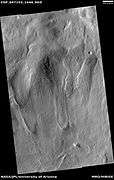 Wide view of tongue-shaped flows, as seen by HiRISE under the HiWish program
Wide view of tongue-shaped flows, as seen by HiRISE under the HiWish program Close view of tongue-shaped flows, as seen by HiRISE under the HiWish program
Close view of tongue-shaped flows, as seen by HiRISE under the HiWish program Close view of tongue-shaped flows and polygonal terrain (which is labeled), as seen by HiRISE under the HiWish program
Close view of tongue-shaped flows and polygonal terrain (which is labeled), as seen by HiRISE under the HiWish program Close view o polygonal terrain near tongue-shaped flows, as seen by HiRISE under the HiWish program
Close view o polygonal terrain near tongue-shaped flows, as seen by HiRISE under the HiWish program
Channels
- Mad Vallis, as seen by HiRISE. Picture on right is an enlargement of part of the other picture.
 Channels, as seen by HiRISE under HiWish program.
Channels, as seen by HiRISE under HiWish program. Streamlined shape in old river valley, as seen by HiRISE under HiWish program. The streamlined shape is evidence of running water.
Streamlined shape in old river valley, as seen by HiRISE under HiWish program. The streamlined shape is evidence of running water. Channel, as seen by HiRISE under HiWish program
Channel, as seen by HiRISE under HiWish program Channel, as seen by HiRISE under HiWish program
Channel, as seen by HiRISE under HiWish program
Layers
 Wide view of layers, as seen by HiRISE under HiWish program
Wide view of layers, as seen by HiRISE under HiWish program Close view of layered deposit in crater, as seen by HiRISE under HiWish program
Close view of layered deposit in crater, as seen by HiRISE under HiWish program Close view of layers, as seen by HiRISE under HiWish program
Close view of layers, as seen by HiRISE under HiWish program Layered formation, as seen by HiRISE under HiWish program
Layered formation, as seen by HiRISE under HiWish program Close view of layers from previous image, as seen by HiRISE under HiWish program
Close view of layers from previous image, as seen by HiRISE under HiWish program Layers, as seen by HiRISE under HiWish program
Layers, as seen by HiRISE under HiWish program Wide view of layers, as seen by HiRISE under HiWish program
Wide view of layers, as seen by HiRISE under HiWish program Channel of a gully indicated with arrows Picture enlarged from previous image
Channel of a gully indicated with arrows Picture enlarged from previous image Close view of layers, as seen by HiRISE under HiWish program
Close view of layers, as seen by HiRISE under HiWish program
Additional Images
- Hellas quadrangle map showing two large river valleys that slope left, toward the floor of the crater.
 Field of hollows, as seen by HiRISE under HIWish program
Field of hollows, as seen by HiRISE under HIWish program Surface features, as seen by HiRISE under HIWish program
Surface features, as seen by HiRISE under HIWish program- Banded or taffy-pull terrain in Hellas, as seen by Mars Global Surveyor. Origin is unknown at present.
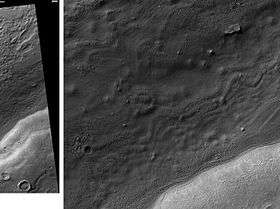 Centauri Montes, as seen by HiRISE. Scale bar is 500 meters long. The original enlargement of the image at the left is full of rich detail on all parts of the picture.
Centauri Montes, as seen by HiRISE. Scale bar is 500 meters long. The original enlargement of the image at the left is full of rich detail on all parts of the picture.- Ausonia Mensa, as seen by MGS, under the MOC Public Targeting Program. This eroded mensa has many channels.
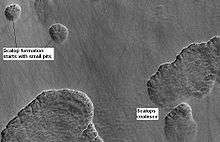 Stages in scalop formation, as seen by HiRISE. These formations probably form from the sublimation of ground rich in pure water ice many meters in depth.[46]
Stages in scalop formation, as seen by HiRISE. These formations probably form from the sublimation of ground rich in pure water ice many meters in depth.[46] Patterned ground in Hellas, as seen by HiRISE under HiWish program The rectangle shows the size of a football field.
Patterned ground in Hellas, as seen by HiRISE under HiWish program The rectangle shows the size of a football field. Possible dike and troughs, as seen by HiRISE under HiWish program The arrows point to the possible dike along the left edge of picture. Straight features are rare in nature; they are often due to dikes and joints.
Possible dike and troughs, as seen by HiRISE under HiWish program The arrows point to the possible dike along the left edge of picture. Straight features are rare in nature; they are often due to dikes and joints. Circular layers, as seen by HiRISE under HiWish program
Circular layers, as seen by HiRISE under HiWish program layers and ridges that form strange patterns, as seen by HiRISE under HiWish program
layers and ridges that form strange patterns, as seen by HiRISE under HiWish program Close view of ridges forming strange patterns, as seen by HiRISE under HiWish program
Close view of ridges forming strange patterns, as seen by HiRISE under HiWish program Odd shapes, as seen by HiRISE under HiWish program part of this image is enlarged in next image.
Odd shapes, as seen by HiRISE under HiWish program part of this image is enlarged in next image. Ridges forming from cracks, as seen by HiRISE under HiWish program Box in upper left shows size of football field.
Ridges forming from cracks, as seen by HiRISE under HiWish program Box in upper left shows size of football field. Dunes, as seen by HiRISE under HiWish program
Dunes, as seen by HiRISE under HiWish program Wide view of brain terrain, as seen by HiRISE under HiWish program
Wide view of brain terrain, as seen by HiRISE under HiWish program Close, side view of brain terrain from previous image, as seen by HiRISE under HiWish program
Close, side view of brain terrain from previous image, as seen by HiRISE under HiWish program
Other Mars quadrangles
Interactive Mars map
See also
References
- ↑ Davies, M.E.; Batson, R.M.; Wu, S.S.C. (1992). "Geodesy and Cartography". In Kieffer, H.H.; Jakosky, B.M.; Snyder, C.W.; et al. Mars. Tucson: University of Arizona Press. ISBN 978-0-8165-1257-7.
- 1 2 3 4 Carr, Michael H. (2006). The Surface of Mars. Cambridge University Press. p. . ISBN 978-0-521-87201-0.
- 1 2 Moore, J; Wilhelms, Don E. (2001). "Hellas as a possible site of ancient ice-covered lakes on Mars". Icarus. 154 (2): 258–276. Bibcode:2001Icar..154..258M. doi:10.1006/icar.2001.6736.
- ↑ Cabrol, N. and E. Grim (eds). 2010. Lakes on Mars
- 1 2 3 Martian Weather Observation MGS radio science measured 11.50 mbar at 34.4° S 59.6° E -7152 meters.
- ↑ http://hirise.lpl.arizonai.edu/P/sP_008559_1405
- ↑ Voelker, M., et al. 2016. DISTRIBUTION AND EVOLUTION OF LACUSTRINE AND FLUVIAL FEATURES IN HELLAS PLANITIA, MARS, BASED ON PRELIMINARY RESULTS OF GRID-MAPPING. 47th Lunar and Planetary Science Conference (2016) 1228.pdf.
- ↑ Kargel, J.; Strom, R. (1991). "Terrestrial glacial eskers: analogs for martian sinuous ridges" (PDF). LPSC. XXII: 683–684. Bibcode:1991LPI....22..683K.
- ↑ Head, JW; Neukum, G; Jaumann, R; Hiesinger, H; Hauber, E; Carr, M; Masson, P; Foing, B; et al. (2005). "Tropical to mid-latitude snow and ice accumulation, flow and glaciation on Mars". Nature. 434 (7031): 346–350. Bibcode:2005Natur.434..346H. doi:10.1038/nature03359. PMID 15772652.
- ↑ http://www.marstoday.com/news/viewpr.html?pid=18050
- ↑ http://news.brown.edu/pressreleases/2008/04/martian-glaciers
- ↑ Plaut, Jeffrey J.; Safaeinili, Ali; Holt, John W.; Phillips, Roger J.; Head, James W.; Seu, Roberto; Putzig, Nathaniel E.; Frigeri, Alessandro (2009). "Radar Evidence for Ice in Lobate Debris Aprons in the Mid-Northern Latitudes of Mars" (PDF). Geophysical Research Letters. 36 (2): n/a. Bibcode:2009GeoRL..3602203P. doi:10.1029/2008GL036379.
- ↑ Holt, J.W.; Safaeinili, A.; Plaut, J. J.; Young, D. A.; Head, J. W.; Phillips, R. J.; Campbell, B. A.; Carter, L. M.; Gim, Y.; Seu, R.; Sharad Team (2008). "Radar Sounding Evidence for Ice within Lobate Debris Aprons near Hellas Basin, Mid-Southern Latitudes of Mars" (PDF). Lunar and Planetary Science. XXXIX: 2441. Bibcode:2008LPI....39.2441H.
- ↑ Holt, J. W.; Safaeinili, A.; Plaut, J. J.; Head, J. W.; Phillips, R. J.; Seu, R.; Kempf, S. D.; Choudhary, P.; et al. (2008). "Radar Sounding Evidence for Buried Glaciers in the Southern Mid-Latitudes of Mars". Science. 322 (5905): 1235–8. Bibcode:2008Sci...322.1235H. doi:10.1126/science.1164246. PMID 19023078.
- ↑ http://themis.asu.edu/zoom-20021022a
- ↑ MLA NASA/Jet Propulsion Laboratory (December 18, 2003). "Mars May Be Emerging From An Ice Age". ScienceDaily. Retrieved February 19, 2009.
- ↑ Carr, M. 2001.
- ↑ Morgenstern, A., et al. 2007
- 1 2 Baker, D., J. Head. 2015. Extensive Middle Amazonian mantling of debris aprons and plains in Deuteronilus Mensae, Mars: Implication for the record of mid-latitude glaciation. Icarus: 260, 269-288.
- ↑ Mangold, N. 2003. Geomorphic analysis of lobate debris aprons on Mars at Mars Orbiter Camera scale: Evidence for ice sublimation initiated by fractures. J. Geophys. Res. 108, 8021.
- ↑ Levy, J. et al. 2009. Concentric
- ↑ Bright Chunks at Phoenix Lander's Mars Site Must Have Been Ice – Official NASA press release (19.06.2008)
- 1 2 http://www.nasa.gov/mission_pages/phoenix/news/phoenix-20080619.html
- ↑ Byrne, S. et al. 2009. Distribution of Mid-Latitude Ground Ice on Mars from New Impact Craters: 329.1674-1676
- ↑ Smith, P., et al. 2009. H2O at the Phoenix Landing Site. Science: 325, 58-61.
- ↑ Head, J. et al. 2003.
- ↑ Madeleine, et al. 2014.
- ↑ Schon, et al. 2009. A recent ice age on Mars: Evidence for climate oscillations from regional layering in mid-latitude mantling deposits. Geophys. Res. Lett. 36, L15202.
- ↑ Touma J. and J. Wisdom. 1993. The Chaotic Obliquity of Mars. Science 259, 1294-1297.
- ↑ Laskar, J., A. Correia, M. Gastineau, F. Joutel, B. Levrard, and P. Robutel. 2004. Long term evolution and chaotic diffusion of the insolation quantities of Mars. Icarus 170, 343-364.
- ↑ Levy, J., J. Head, D. Marchant, D. Kowalewski. 2008. Identification of sublimation-type thermal contraction crack polygons at the proposed NASA Phoenix landing site: Implications for substrate properties and climate-driven morphological evolution. Geophys. Res. Lett. 35. doi:10.1029/2007GL032813.
- ↑ Levy, J., J. Head, D. Marchant. 2009a. Thermal contraction crack polygons on Mars: Classification, distribution, and climate implications from HiRISE observations. J. Geophys. Res. 114. doi:10.1029/2008JE003273.
- ↑ Hauber, E., D. Reiss, M. Ulrich, F. Preusker, F. Trauthan, M. Zanetti, H. Hiesinger, R. Jaumann, L. Johansson, A. Johnsson, S. Van Gaselt, M. Olvmo. 2011. Landscape evolution in Martian mid-latitude regions: insights from analogous periglacial landforms in Svalbard. In: Balme, M., A. Bargery, C. Gallagher, S. Guta (eds). Martian Geomorphology. Geological Society, London. Special Publications: 356. 111-131
- ↑ Laskar, J., A. Correia, M. Gastineau, F. Joutel, B. Levrard, and P. Robutel. 2004. Long term evolution and chaotic diffusion of the insolation quantities of Mars. Icarus 170, 343-364.
- 1 2 Mellon, M., B. Jakosky. 1995. The distribution and behavior of Martian ground ice during past and present epochs. J. Geophys. Res. 100, 11781–11799.
- ↑ Schorghofer, N., 2007. Dynamics of ice ages on Mars. Nature 449, 192–194.
- ↑ Madeleine, J., F. Forget, J. Head, B. Levrard, F. Montmessin. 2007. Exploring the northern mid-latitude glaciation with a general circulation model. In: Seventh International Conference on Mars. Abstract 3096.
- ↑ http://themis.asu.edu/zoom-20020807a
- ↑ http://marsrovers.jpl.nasa.gov/gallery/press/spirit/20070412a.html
- ↑ http://mars.jpl.nasa.gov/spotlight/KenEdgett.html
- ↑ Reiss, D. et al. 2011. Multitemporal observations of identical active dust devils on Mars with High Resolution Stereo Camera (HRSC) and Mars Orbiter Camera (MOC). Icarus. 215:358-369.
- ↑ Malin, M. C.; Edgett, K. S.; Posiolova, L. V.; McColley, S. M.; Dobrea, E. Z. N. (2006). "Present-Day Impact Cratering Rate and Contemporary Gully Activity on Mars". Science. 314 (5805): 1573–1577. Bibcode:2006Sci...314.1573M. doi:10.1126/science.1135156. PMID 17158321.
- ↑ McEwen, AS; Hansen, CJ; Delamere, WA; Eliason, EM; Herkenhoff, KE; Keszthelyi, L; Gulick, VC; Kirk, RL; et al. (2007). "A Closer Look at Water-Related Geologic Activity on Mars". Science. 317 (5845): 1706–1709. Bibcode:2007Sci...317.1706M. doi:10.1126/science.1143987. PMID 17885125.
- ↑ http://www.lpi.usra.edu/publications/slidesets/stones/
- ↑ Kieffer, Hugh H. (1992). Mars. Tucson: University of Arizona Press. pp. . ISBN 0-8165-1257-4.
- ↑ Dundas, C., S. Bryrne, A. McEwen. 2015. Modeling the development of martian sublimation thermokarst landforms. Icarus: 262, 154-169.
- 1 2 Morton, Oliver (2002). Mapping Mars: Science, Imagination, and the Birth of a World. New York: Picador USA. p. 98. ISBN 0-312-24551-3.
- ↑ "Online Atlas of Mars". Ralphaeschliman.com. Retrieved December 16, 2012.
- ↑ "PIA03467: The MGS MOC Wide Angle Map of Mars". Photojournal. NASA / Jet Propulsion Laboratory. February 16, 2002. Retrieved December 16, 2012.
- ↑ "Online Atlas of Mars". Ralphaeschliman.com. Retrieved December 16, 2012.
- ↑ "PIA03467: The MGS MOC Wide Angle Map of Mars". Photojournal. NASA / Jet Propulsion Laboratory. February 16, 2002. Retrieved December 16, 2012.
External links
| Wikimedia Commons has media related to Hellas quadrangle. |
| Quadrangles on Mars | ||||||||||||||||||||||||||||||||||||||||||||||||||||||||||||||||||||||||||||||||||||||||||||||||||||||||||||||||||||||||||||||||||||||||||||||||
|---|---|---|---|---|---|---|---|---|---|---|---|---|---|---|---|---|---|---|---|---|---|---|---|---|---|---|---|---|---|---|---|---|---|---|---|---|---|---|---|---|---|---|---|---|---|---|---|---|---|---|---|---|---|---|---|---|---|---|---|---|---|---|---|---|---|---|---|---|---|---|---|---|---|---|---|---|---|---|---|---|---|---|---|---|---|---|---|---|---|---|---|---|---|---|---|---|---|---|---|---|---|---|---|---|---|---|---|---|---|---|---|---|---|---|---|---|---|---|---|---|---|---|---|---|---|---|---|---|---|---|---|---|---|---|---|---|---|---|---|---|---|---|---|---|
| ||||||||||||||||||||||||||||||||||||||||||||||||||||||||||||||||||||||||||||||||||||||||||||||||||||||||||||||||||||||||||||||||||||||||||||||||
